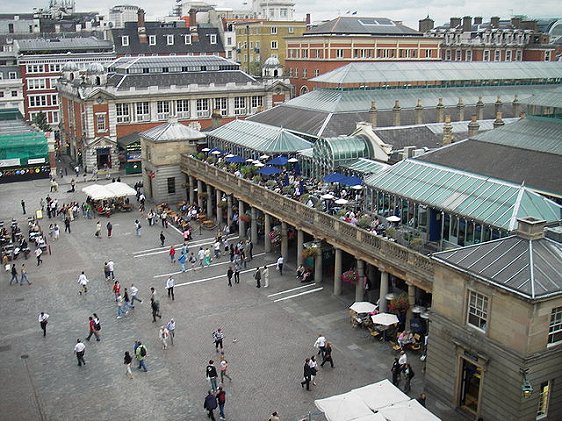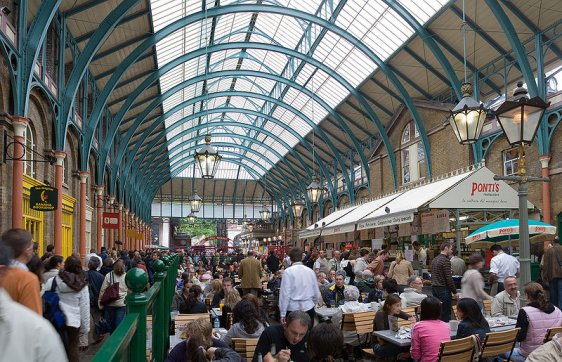Covent Garden is bordered by High Holborn to the north, Kingsway to the east, The Strand to the south and Charing Cross Road to the west. At the very centre is the Covent Garden Piazza, which was where a flower, fruit and vegetable market was located from the 1500s until 1974 when it moved to New Covent Garden Market in Nine Elms. Nearby areas include Soho, St James's, Bloomsbury and Holborn.
 Covent Garden Market and Jubilee Hall
Covent Garden Market and Jubilee HallSource: https://commons.wikimedia.org/wiki/File:Covent_Garden_Market_and_Jubilee_Hall_-_geograph.org.uk_-_215174.jpg
Author: David Hawgood

The name Covent Garden was originally "Convent Garden". It came about during the reign of King John (1199-1216), and referred to a 40-acre area in the county of Middlesex, bordered west and east by what is now St. Martin's Lane and Drury Lane, and north and south by Floral Street. The name referred to a quadrangle within the Convent of St Peter in Westminster. The monk's large kitchen garden was a source of fruit and vegetables during the Middle Ages for the people of London, and was managed by leaseholders by grant from the Abbot. This kitchen garden, or convent garden, was how Covent Garden got its name.
In 1540, King Henry VII dissolved the monasteries and appropriated their land. In so doing, he granted part of the land of Covent Garden to Baron Russell, Lord High Admiral and, later, Earl of Bedford. King Edward VI bestowed the remainder of the garden land in 1547 to his maternal uncle, Edward Seymour, the Duke of Somerset, who began building Somerset House on the south side of Strand the next year. After Seymour was beheaded for treason in 1552, the land was awarded four months later to the person who contributed to Seymour's downfall, the Earl of Bedford.
Covent Garden as we know it today was developed in the early 17th century by Francis Russel, the 4th Earl of Bedford. Designed by famous English Renaissance architect Inigo Jones, Covent Garden was planned to be a market centre. At the centre is an arcaded piazza. To the west of the piazza is the church of St Paul's, Covent Garden, better known as Actors' Church.
Covent Garden became the most important market place for traders, especially after the Great Fire of London of 1666, which burned down other "rival" markets on the eastern part of the city. The first mention of a Punch and July show in Britain was recorded at being performed at Covent Garden in May 1662. The grand building that look like Roman baths used as a permanent trading centre was built in 1830.
 Interior of the Covent Garden Market
Interior of the Covent Garden MarketSource: https://commons.wikimedia.org/wiki/File:Covent_Garden_Interior_May_2006.jpg
Author: David Iliff

In 1913, the Duke of Bedford, feeling pressured to diversify his portfolio, sold Covent Garden to Harry Mallaby-Deeley for £2 million. Mallaby-Deeley sold his option to buy to Sir Joseph Beecham. However, Sir Joseph died the following year, and his sons Sir Thomas and Henry finalised the purchase.
By the end of the 1960s, traffic congestion was making development of Covent Garden as a market place unsustainable. Eventually the market moved to New Covent Garden Market three miles southwest in 1974. The deserted square was only reopened as a shopping centre in 1980.
Today, Covent Garden is well known for its shops, and for street performers - it is the only part of London licensed for such performances. The performers have to audition and the performer's union draws up a performance timetable. UK's first food Night Market was launched here in August 2007, in an attempt to bring back Covent Garden's position as the "Larder of London". Among the stalls at the Night Market include Neal's Yard's specialist cheeses, Spore Boys' mushroom sandwiches, Gourmet Candy Company, Ginger Pig sausages and Burnt Sugar fudge.
How to go to Covent Garden
Take the Piccadilly Line of the London Underground to the Covent Garden Tube Station.List of Places in London
 Latest updates on Penang Travel Tips
Latest updates on Penang Travel Tips
 Discover with Timothy YouTube Channel
Discover with Timothy YouTube Channel
 PG Food Channel
PG Food Channel
 Learn Penang Hokkien YouTube Channel
Learn Penang Hokkien YouTube Channel
 SojiMart Videos
SojiMart Videos
Latest from Discover with Timothy: Gurney Bay - what to see and do there
About this website

Hello and thanks for reading this page. My name is Timothy and my hobby is in describing places so that I can share the information with the general public. My website has become the go to site for a lot of people including students, teachers, journalists, etc. whenever they seek information on places, particularly those in Malaysia and Singapore. I have been doing this since 5 January 2003, for over twenty years already. You can read about me at Discover Timothy. By now I have compiled information on thousands of places, mostly in Peninsular Malaysia and Singapore, and I continue to add more almost every day. My goal is to describe every street in every town in Malaysia and Singapore.
Robbie's Roadmap
- Episode 1: Robbie's Journey to Financial Freedom
- Episode 2: Lost in America
- Episode 3: The Value of Money
- Episode 4: The Mentor
- Episode 5: The Thing that Makes Money
- Episode 6: The walk with a Billionaire
- Episode 7: The Financial Freedom Awakening
- Episode 8: Meet Mr Washington
- Episode 9: The Pizzeria Incident
Copyright © 2003-2024 Timothy Tye. All Rights Reserved.


 Go Back
Go Back